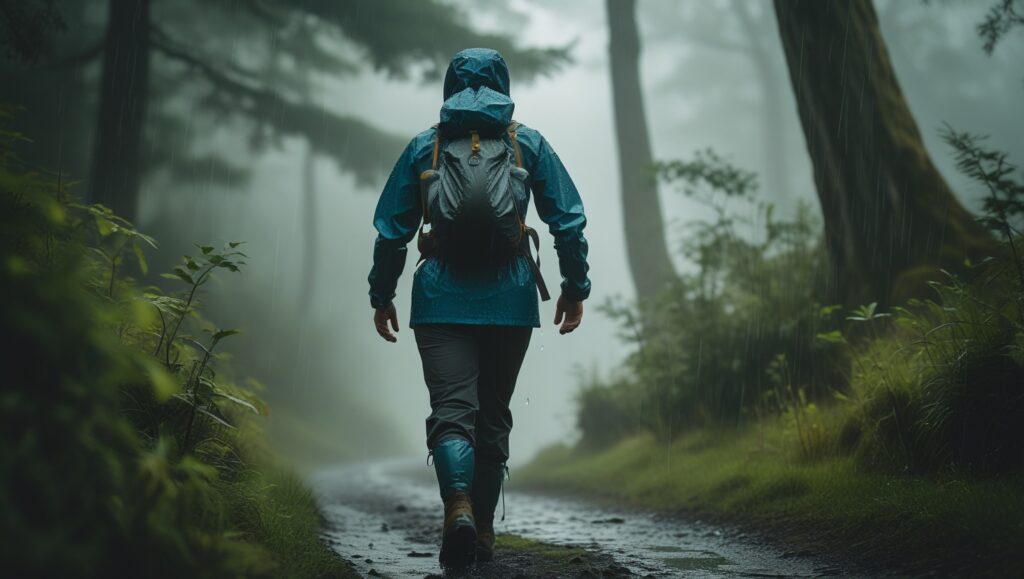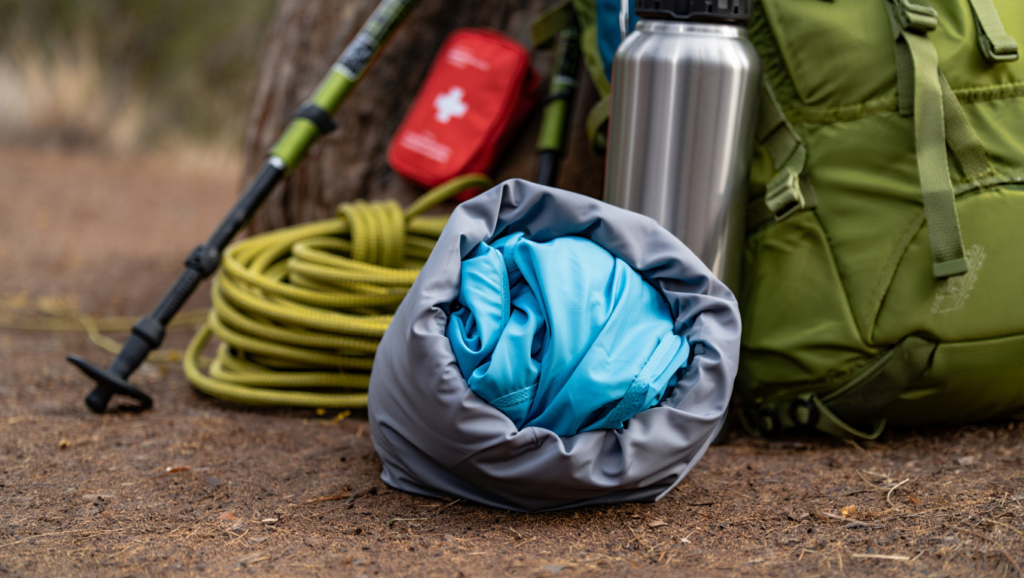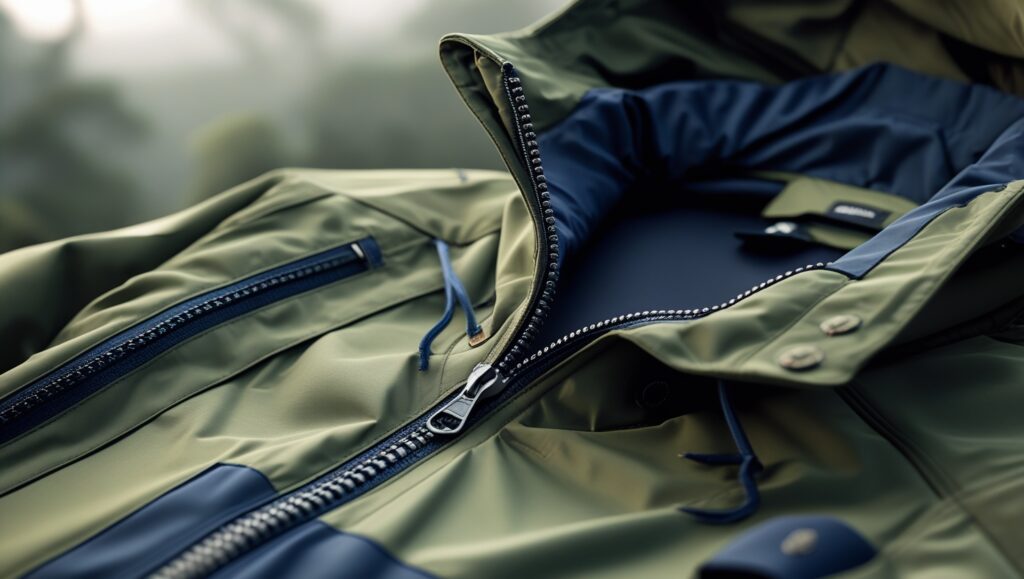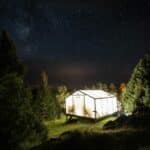Introduction
When you’re miles from shelter and the weather turns, a good rain jacket isn’t just convenient — it’s essential. For backpackers, the challenge is finding a jacket that offers real protection without adding bulk or weight to your pack.
In this guide, we’ve reviewed and compared some of the best rain jackets for backpacking in 2025 — focusing on lightweight rain protection for multi-day hikes and unpredictable trail conditions. Whether you’re heading out for a weekend trek or a thru-hike, these options strike the right balance between durability, packability, and price — making them top picks for anyone seeking ultralight hiking jackets as part of their waterproof backpacking gear setup.

Quick Comparison Table
| Jacket Name | Weight | Waterproof Rating | Best For | Price Range |
| Patagonia Torrentshell | ~12 oz | 20,000 mm | All-season backpacking | $$$ |
| Outdoor Research Helium | ~6.3 oz | 10,000 mm | Ultralight, emergency use | $$ |
| Marmot PreCip Eco | ~10.6 oz | 10,000 mm | Budget-friendly hiking | $$ |
| Arc’teryx Zeta SL | ~10.9 oz | 28,000 mm | High-performance + comfort | $$$$ |
| Frogg Toggs UL2 | ~10 oz | Unrated (non-membrane) | Budget, packable, dry trails | $ |
| REI Co-op Rainier | ~11.4 oz | 10,000 mm | Versatile all-around pick | $$ |
| Montbell Versalite | ~6.4 oz | 20,000 mm | Fastpacking, gram-counters | $$$ |

Patagonia Torrentshell 3L
Patagonia’s Torrentshell 3L stands out as a reliable, fully waterproof shell — a lightweight rain jacket for hiking in tough conditions, designed for backpackers who don’t want to compromise on durability. It uses a 3-layer H2No Performance Standard membrane with a 20,000 mm waterproof rating — significantly more robust than most 2.5-layer jackets in the same weight class.
This jacket is often praised by long-distance hikers and weekend backpackers alike for its ability to withstand sustained rain without wetting out — making it a trusted rain protection option for backcountry use. The microfleece-lined neck adds comfort, and the pit zips provide ventilation during uphill climbs or humid conditions.
Based on Reviews
Backpackers consistently highlight the Torrentshell’s durability and confidence in extended storms. Many note that even after a year of use, the jacket continues to repel water effectively. The DWR (durable water repellent) finish holds up better than expected, and the zippers are described as smooth and secure even after repeated stuffing into backpacks.
One common observation is that the fit is slightly boxy — which some appreciate for layering — while others wish for a more athletic cut. In reviews from colder regions, users appreciated the room to wear a midlayer underneath without restricting movement.
A few hikers point out that while it’s heavier than ultralight shells (around 12 oz), it’s also the one they reach for when they know real weather is coming — prioritizing serious waterproof performance over weight savings.
Pros
- Excellent waterproofing for multi-day or high-rain trips
- Durable 3-layer fabric that doesn’t feel clammy
- Pit zips and microfleece collar add comfort and function
- Recycled nylon shell and strong environmental credentials
Cons
- Bulkier and heavier than ultralight options
- Boxy fit may not suit all body types
- No internal pocket or stuff sack included
Outdoor Research Helium
The Outdoor Research Helium is a minimalist’s go-to rain shell, built for ultralight backpacking, fastpacking, and emergency weather protection — a packable waterproof jacket trusted by many thru-hikers. Weighing just 6.3 ounces, it’s one of the lightest fully waterproof jackets on the market — ideal for hikers counting every gram.
This jacket uses OR’s proprietary Pertex Shield+ 2.5-layer laminate, which offers a 10,000 mm waterproof rating with good breathability for its class. The fabric is noticeably thin, but surprisingly tough for its weight — providing lightweight rain protection for unpredictable weather, refined through multiple iterations and field feedback.
Based on Reviews
Many backpackers carry the Helium as their emergency shell on long treks, often as part of their ultralight hiking setup. It’s often stored in the brain of the pack or clipped to the outside via its integrated stuff sack. Hikers like that it doesn’t take up room or weight, but still offers reliable water resistance when needed.
Users praise the updated version’s reinforced durability (especially the diamond ripstop material) and improved zippers. Several note that it sheds light to moderate rain well but may soak through in all-day storms — confirming it’s more of a just-in-case layer than a stormproof shell.
One frequent critique is the lack of pit zips, which limits temperature regulation. Another is the slim fit — excellent for fast hikers, but tight for layering or broader frames.
Pros
- Ultralight and extremely compact
- Improved durability over earlier versions
- Integrated stuff sack and carabiner loop
- Excellent for “just-in-case” use in variable weather
Cons
- Not ideal for prolonged rain or bushwhacking
- No pit zips or adjustable cuffs
- Fit runs narrow and short for some users
Marmot PreCip Eco
The Marmot PreCip Eco has built a solid reputation as a budget-friendly rain jacket that performs above its price point — a top choice among entry-level waterproof backpacking gear options. It’s especially popular among beginner and intermediate backpackers who want reliable waterproofing without a premium price tag.
The Eco version uses Marmot’s NanoPro™ waterproof breathable coating, rated at 10,000 mm, with a PFC-free DWR finish and recycled nylon fabric. It weighs around 10.6 oz and packs into its own pocket, making it easy to toss in a daypack or carry for thru-hikes as lightweight rain gear for weekend trips or emergencies.
Based on Reviews
Hikers consistently highlight the value this jacket offers. It’s often described as the “first real shell” many backpackers buy — especially for those building their first backpacking gear setup. In moderate rain and shorter trips, the PreCip Eco holds up well. The fully taped seams and adjustable hood get frequent praise for doing their job.
The pit zips are a standout feature in this price range. Backpackers say they make a big difference during climbs or warm-weather hikes. However, breathability is still limited compared to more expensive 3-layer jackets. Some users report a clammy feel in humid conditions.
In terms of fit, the jacket tends to be roomy enough for light layering. Multiple reviewers mention the fabric feeling slightly stiff out of the box, but softening with use.
Durability is a mixed bag: great for occasional use, but some users note delamination or DWR failure after 1–2 seasons of heavy use.
Pros
- Excellent value for the price
- Pit zips and packability add real-world usability
- Recycled materials and eco-friendly DWR
- Solid weather protection for short to moderate trips
Cons
- Less breathable than higher-end shells
- Fabric feels stiff initially
- DWR may wear off with frequent use
Arc’teryx Zeta SL
The Arc’teryx Zeta SL is a high-end rain shell built for serious backpackers who prioritize protection, comfort, and premium construction — offering ultralight rain protection for long-distance treks and alpine use. It features a 2-layer GORE-TEX PACLITE Plus membrane with a 28,000 mm waterproof rating — one of the highest in its class — while still maintaining a lightweight 10.9 oz profile.
This jacket is tailored more for multi-day hikers, alpine environments, and anyone who expects extended exposure to rain and wind during multi-day hikes or backcountry travel.
Based on Reviews
Users overwhelmingly praise the Zeta SL’s balance of packability and performance. It’s consistently described as the most “wearable” shell among high-performance jackets, with a soft-feeling interior and ergonomic design. The articulated patterning and slightly longer cut make it comfortable for movement, layering, and long days on the trail.
The GORE-TEX membrane performs extremely well in sustained rain. Many reviewers report staying dry even in multi-hour storms, with no noticeable wetting-out. Zippers, hood adjustment, and seam taping all reflect Arc’teryx’s premium build quality — and it shows in longevity.
However, it’s not flawless. Some users feel it’s overpriced for a 2-layer jacket, and note that it lacks features like pit zips or internal pockets. Still, for those who want an “always pack it, never worry” rain layer, it delivers.
Pros
- Outstanding waterproofing and long-term reliability
- Premium materials and construction
- Excellent fit and mobility on the trail
- Lightweight for the protection it provides
Cons
- Expensive, even compared to other GORE-TEX jackets
- No pit zips or venting options
- May be overbuilt for casual weekend hikers
Frogg Toggs UL2
The Frogg Toggs UL2 is a no-frills, budget rain jacket — a true ultralight emergency rain shell for minimalist hikers and thru-hikers alike. It’s popular among thru-hikers, emergency kit preppers, and budget-minded backpackers who need basic weather protection without the weight or cost of traditional shells.
Made from non-woven polypropylene rather than standard membrane fabrics, it has no formal waterproof rating — but in real-world use, it repels water well enough for short-term or moderate use.
Based on Reviews
What hikers love most about the UL2 is how absurdly light and cheap it is. We’re talking around 10 oz and typically under $30. Many thru-hikers keep it in their packs for emergency storms or as a backup shell in their lightweight rain gear setup. Reviewers regularly note that it holds up surprisingly well — but always with the caveat that it’s fragile.
Durability is the tradeoff. Users report tearing from brushing against rocks or tree branches. The material doesn’t stretch and is prone to seam failure with extended use or rough handling.
It’s also not the best fit — the cut is loose and boxy, which some appreciate for ventilation, while others find it awkward to layer. Still, for short trips or as an ultralight contingency layer, it punches far above its price.
Pros
- Extremely affordable
- Ultralight and very compact
- Surprisingly effective for moderate rain
- Great backup jacket or for low-risk trips
Cons
- Tears easily with abrasion or strain
- Very basic construction (no pit zips, thin zipper)
- Fit is loose and lacks adjustability
- No long-term durability for rough or extended use
REI Co-op Rainier
The REI Co-op Rainier is a well-rounded rain jacket — an affordable rain jacket for backpacking and travel that balances performance with price. It’s especially popular among entry-level backpackers and travelers who want solid waterproofing without breaking the bank.
Built with a 2.5-layer recycled nylon fabric and a 10,000 mm waterproof rating, it includes features often missing at this price point: pit zips, adjustable cuffs, and a storm flap over the zipper. At about 11.4 oz, it’s not ultralight — but offers a solid middle ground between performance and comfort.
If you’re focused on cutting every gram, you may also want to check out our guide to camping tools under 100g — minimalist picks that won’t weigh you down.
Based on Reviews
Hikers consistently describe the Rainier as a dependable “all-arounder” and a great option for waterproof gear in everyday outdoor use. It’s widely praised for features that usually cost more — especially pit zips and a fully adjustable hood. Many reviewers say it performs better than expected during heavy rain on trails or during multi-hour downpours in the city.
The fit is relatively generous, making it easy to layer underneath, though some say it feels bulky for warmer weather. The recycled materials and PFC-free DWR coating are a welcome bonus for environmentally conscious buyers.
Durability is good for its price. While not built for bushwhacking or alpine storms, users say it holds up well with regular use. A few report the fabric wetting out over time, but most agree reapplying DWR restores performance.
Pros
- Affordable but feature-rich (pit zips, adjustable hood, storm flap)
- Good waterproofing for multi-use situations
- Ethical build using recycled materials
- Comfortable for longer wear and travel
Cons
- Bulkier and heavier than ultralight jackets
- Not ideal for technical or alpine conditions
- Fit can feel oversized on smaller frames
Montbell Versalite
The Montbell Versalite is a favorite among ultralight backpackers and fastpackers who want top-tier waterproofing in the lightest package possible. At just 6.4 oz, it competes directly with jackets like the OR Helium — but with far more features and higher performance.
This shell uses a 2-layer Gore-Tex Infinium Windstopper with a 20,000 mm waterproof rating and fully taped seams. It includes pit zips, zippered pockets, adjustable cuffs, and a hood — all rare in a sub-7 oz jacket.
Based on Reviews
Backpackers rave about the Versalite’s weight-to-feature ratio. It’s regularly described as “the only true ultralight shell that doesn’t feel like a trash bag.” The fabric is light but not crinkly, and the inclusion of full-length pit zips makes it functional in variable climates.
One standout feature is the breathability. While it won’t compete with 3-layer alpine shells, reviewers say it holds up surprisingly well on long climbs and humid trails. Most use it as a daily rain layer in ultralight setups — and not just as an emergency shell.
The biggest drawback is the price. At $200–250, it’s an investment, and some hikers question whether it’s worth the premium over slightly heavier, cheaper options. Others point out that durability can suffer with frequent bushwhacking or pack abrasion.
Pros
- One of the lightest jackets with full features (pit zips, pockets, hood)
- Excellent waterproofing for its weight
- Great for thru-hiking, fastpacking, and minimalist setups
- More breathable than most 2-layer ultralight shells
Cons
- Expensive for the weight class
- Not as durable under frequent abrasion
- Slim fit may limit layering in colder weather

What to Look for in a Backpacking Rain Jacket
Choosing the right rain jacket depends on where, how, and how often you hike. Here’s what matters most:
- Waterproofing (membrane + rating)
Look for at least 10,000 mm waterproof rating and fully taped seams. For alpine or multi-day hikes, consider 3-layer construction or Gore-Tex. - Weight and Packability
If you’re ultralight or thru-hiking, every ounce counts. Sub-10 oz jackets excel in pack size and weight but may compromise durability. - Ventilation
Pit zips, breathable fabrics, and mesh-lined pockets help regulate body temperature. Lack of airflow can turn a rain jacket into a sauna. - Durability
For regular use or rugged trails, 3-layer jackets and reinforced fabrics are worth the weight. Ultralight jackets often trade toughness for grams. - Fit and Adjustability
A good fit allows freedom of movement and layering. Adjustable hoods, cuffs, and hems prevent water seepage and improve comfort in wind. - Price vs. Purpose
You don’t always need the most expensive jacket. Match your budget to your needs — casual day hikes require less than thru-hikes in volatile climates.
Mistakes to Avoid When Buying One
- Buying based on price alone. The cheapest jackets often fail in long or wet hikes. Balance cost with function.
- Ignoring ventilation. A jacket without airflow quickly becomes uncomfortable. Look for pit zips or at least breathable fabrics.
- Overlooking durability. Ultralight isn’t always better — especially in rough terrain or long-term use.
- Choosing poor fit. A too-tight jacket restricts movement and layering. A too-loose one lets rain in and flaps in wind.
- Skipping waterproof tests. Don’t wait for a storm to find out your jacket leaks. Do a hose or shower test at home.
Conclusion — Staying Dry, Light, and Ready
A rain jacket isn’t just a backup item — it’s core trail protection. The right jacket keeps you dry without weighing you down or slowing you down. Whether you prioritize low weight, all-day protection, or value, there’s a solid option to match your hiking style.
From minimalist shells like the Outdoor Research Helium and Montbell Versalite to storm-ready performers like the Patagonia Torrentshell and Arc’teryx Zeta SL, every jacket on this list brings something specific to the table. Know your priorities, test your gear, and invest in a layer that lets you hike through the rain — not run from it.
For other lightweight gear options that complement your rain setup, see our picks for compact camping gadgets you’ll actually use.

Frequently Asked Questions
How often should I reapply DWR to my rain jacket?
Most jackets need reapplication every 20–30 wears or when water stops beading on the surface. Use a spray-on or wash-in product, and clean the jacket first for best results.
Can I use a rain jacket as a wind layer?
Yes. Most rain jackets provide full wind protection, especially those with 2.5- or 3-layer designs. However, they may trap heat, so ventilation matters.
What’s the difference between 2-layer, 2.5-layer, and 3-layer jackets?
2-layer: Basic construction, often less breathable
2.5-layer: Lightweight, with inner print or coating
3-layer: Full outer, membrane, and liner layers — more durable and breathable
Each layer count impacts comfort, breathability, and price.
How do I pack a rain jacket for backpacking?
Roll or fold it loosely into a stuff sack or outer pocket. Avoid over-compression if the fabric is thin, and keep it accessible in case of sudden weather changes.
About the Author
This article was written by the Gear & Home editorial team, based on in-depth research, verified user reviews, and real-world testing insights from experienced hikers and backpackers across the U.S.
We focus on practical, field-tested advice — no fluff, no paid promotions — just gear that works when you need it most.








